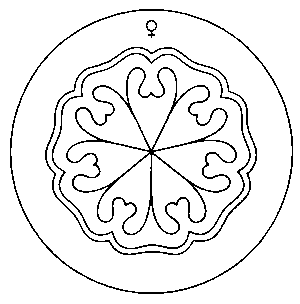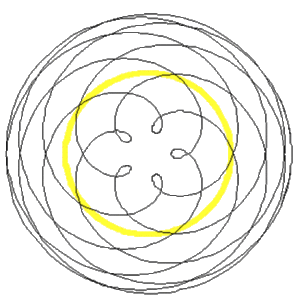Venus


Venus (ancient Egyptian: Netjer-duai; Hebrew: נֹגַהּ Nogah; astronomical sign: ♀) detached itself like Mercury from the Earth and the Sun after their separation. Here, retarded Luciferic Spirits of Form created for themselves a dwelling place appropriate to their level of development, which contained finer substances than the Earth, but less fine ones than the Sun. It should be noted that with the transition to the Copernican system, Venus and Mercury were interchanged in the order of the planets (see → Occult order of planets).
„Venus has the same powers and temperate nature as Jupiter, but acts in the opposite way. For it warms moderately on account of its proximity to the Sun, but moistens chiefly, like the Moon, on account of the quantity of its own light, and because it appropriates to itself the exhalations of the moist atmosphere which surrounds the earth.“
The physical planet

Venus is the second innermost planet in the solar system, with an average distance from the Sun of 108 million kilometres, and the third smallest, with a diameter of about 12,100 kilometres. It is one of the four Earth-like planets, also called terrestrial or rocky planets.
Venus is the planet that comes closest to Earth's orbit in its orbit, with a minimum distance of 38 million kilometres. It is similar in size to the Earth, but differs in geology and especially in its atmosphere. This consists of 96% carbon dioxide and its surface pressure is 90 times higher than on Earth.
After the Moon, Venus is the brightest star in the night sky. Because it is one of the lower planets and is only visible in the morning or evening sky and never around midnight, it is also called the morning star (Greek: Φώσφορος Phosphoros "light-bearer", "light-bringer"; Latin: Lucifer) and the evening star (Greek: Ἕσπερος Hesperos; Latin: Hesperus). Even with a small telescope it can be observed in the daytime sky, sometimes even unaided. But even when it is close to Earth (about every 1½ years), only the cloud streaks of the extremely dense atmosphere can be seen. Exploration of the surface requires radar.
Transit of Venus
A transit of Venus (from Latin transitus "passage") or Venus transit or Venus passage occurs when Venus passes in front of the solar disk. The Sun, Venus and Earth are then exactly in line. Venus then appears as a small black disc with an apparent diameter of 1′ (1/30 of the solar disc). Under good conditions, a Venus transit can also be observed unaided with suitable filter glasses. Due to Venus' orbit being inclined at 3.4° to Earth's orbit, a Venus transit occurs only four times in about 243 years, after 8, another 121½, another 8 and another 105½ years.[1]
The spiritual significance of Venus
Venus pentagram

Venus has a synodic period of just under 584 (exactly 583.92) days. In the course of 8 years, it draws an almost regular pentagram from a geocentric point of view (8*365 = 2920 = 5*584), if you connect the five points closest to the Earth that Venus reaches in these 8 years.This pentagram is the cosmic archetype for many five-rayed earthly forms, for example for the five-rayed symmetry of the blossoms of the Rosaceae (Lit.: Kranich).
Venus sphere
The Venus sphere delimits the dominion of the Spirits of Personality. The leading Archangel is Anael. Venus beings have been stimulating the transformation of the astral body into the spirit self since the last third of the Atlantean period (Lit.: GA 98, p. 198, GA 102, p. 59f).
Venus is also the dominion of Lucifer.
„Thus on Venus also dwell entities which stand between men and the solar entities. They inhabit Venus and can even become effective on earth. They become effective in the human body. We call these entities Luciferic entities. In a certain way they have their home on Venus. That is why Venus is also called 'Lucifer'.“ (Lit.:GA 98, p. 186)
Lucifer works on the physical rays of light. When Venus shows its full disc, Lucifer acts on the lower man; when no light shines from Venus to the Earth, the spiritual Venus acts on the upper man, on the head man, and during the intervening Venus phases the middle man is chiefly influenced.
In the human organism, the Venus forces have a special effect on the kidneys or the whole urogenital system; in language, they show themselves through the vowel A. In plant growth they reveal themselves above all in the formation of blossoms, and copper was created through the influence of the Venus forces. The birch tree is associated with Venus.
See also
- Venus - Article in the English Wikipedia
- Category:Venus - Article in the English Wikipedia
Literature
- Ernst-Michael Kranich: Pflanze und Kosmos, Verlag Freies Geistesleben, Stuttgart 1976
- Rudolf Steiner: Natur- und Geistwesen – ihr Wirken in unserer sichtbaren Welt, GA 98 (1996), ISBN 3-7274-0980-0 English: rsarchive.org German: pdf pdf(2) html mobi epub archive.org
- Rudolf Steiner: Das Hereinwirken geistiger Wesenheiten in den Menschen, GA 102 (2001), ISBN 3-7274-1020-5 English: rsarchive.org German: pdf pdf(2) html mobi epub archive.org
 |
References to the work of Rudolf Steiner follow Rudolf Steiner's Collected Works (CW or GA), Rudolf Steiner Verlag, Dornach/Switzerland, unless otherwise stated.
Email: verlag@steinerverlag.com URL: www.steinerverlag.com. Index to the Complete Works of Rudolf Steiner - Aelzina Books A complete list by Volume Number and a full list of known English translations you may also find at Rudolf Steiner's Collected Works Rudolf Steiner Archive - The largest online collection of Rudolf Steiner's books, lectures and articles in English. Rudolf Steiner Audio - Recorded and Read by Dale Brunsvold steinerbooks.org - Anthroposophic Press Inc. (USA) Rudolf Steiner Handbook - Christian Karl's proven standard work for orientation in Rudolf Steiner's Collected Works for free download as PDF. |
References
- ↑ Der Zyklus der Venusdurchgänge (The cycle of Venus' transits), retrieved 21 April 2021

